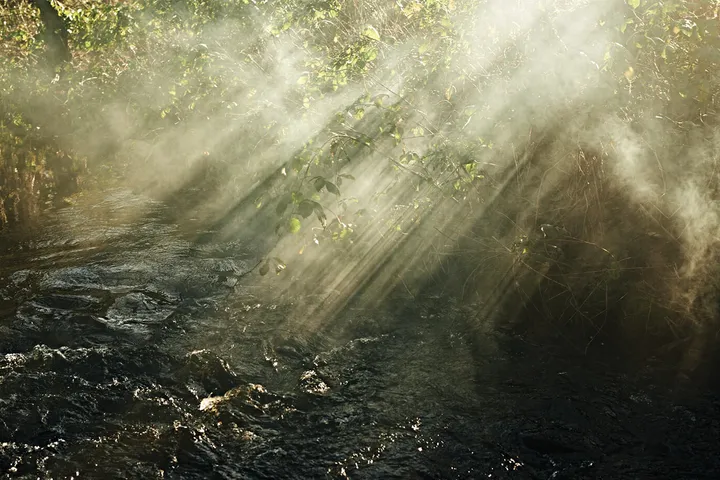My kids love the hot summer sun and cool ocean water, but I’m a sucker for crisp fall air and cups of tea. I adore what I call the threshold seasons (fall and spring) which seem to announce the extremity of the others. Thresholds, in this sense, are those in-between moments when we are on the cusp of change and transformation. Whether we are walking across an actual threshold or a metaphorical one, something mysterious happens in these times of passage. Thresholds promise the world might be upended, though we can’t be sure which way.
 Illustration by Valero Doval
Illustration by Valero Doval
We need threshold seasons in the Christian life, too —spaces to stop, look around, and be welcomed into deeper knowing. That’s because the Christian life isn’t meant to be a steady and always-comfortable, climate-controlled experience. We need new windows and doorways to open in our faith so that it matures. Thresholds provide us with perspective and, as we cross them, experience.
Lent, the six weeks leading up to Easter, is such a season—and one that evangelicals have embraced increasingly in recent decades. It’s poised between what for centuries the church has called “Ordinary Time” and the Easter season (traditionally the 50 days following Easter Sunday). The idea is that, as a period of preparation, it helps our spirits catch up with our bodies, so we’re not plummeted unthinkingly into celebrating Christ’s resurrection. For often, without something to slow us down, our souls are still trying to play catch-up. Lent makes the most of that liminal time: As a threshold, it transitions us toward Easter.
What we often fail to grasp about our faith is that to enter fully into the Christian life, we need things—material things. And it’s always been that way. Just look at the Old Testament. Look at the Gospels. Look at the last week of Jesus’ life: It was chock full of things—a donkey, branches, and cloaks thrown in celebration of the king; water, a basin and a towel to wash the disciples’ feet; bread and wine to celebrate the Passover and institute the Lord’s Supper; and then the sweat that was like blood in the Garden of Gethsemane; whips, the wood of a cross, thorns, dice, vinegar, blood, and a veil torn in two. Resurrection, too, was full of things: burial clothes folded in a tomb, a stone rolled away, jars and spices to anoint Jesus’ body, and a resurrected Christ who then lets Thomas reach into the wounds to see that resurrection is real. Why should it be any different now?
Yes, contrary to what many evangelicals think, God uses physical things, including our own bodies, to usher us across the threshold of His kingdom. And sometimes, that’s best accomplished by intentionally going without or limiting our use of material things—food, in particular—for a period of time. That’s where Lent can help.
When we hear the word “Lent,” we can think of formal church services or quickly box the idea into “it’s what Catholics do.” (I know that’s what I thought as a Protestant attending a Catholic school.) While many traditions (including Catholicism) participate in Lent, it’s actually an ancient Christian practice that dates back to the second century.
As a period of preparation, Lent helps our spirits catch up with our bodies, so we’re not plummeted unthinkingly into celebrating Christ’s resurrection.
In 325 AD, the Council of Nicea established Lent as a period of fasting before baptism (a practice the whole church adopted). Typically, during Lent Christians orient the heart through fasting of the body. Giving up rich food, for instance, during the 40 days is one way we begin to acknowledge the deeper hungers of our soul—and how we often use food (or other things, like technology and shopping) to distract us from ourselves and God. A Lenten fast can recalibrate our hungers. In our church, we anticipate the resurrection by pausing our fasts on Sunday; through feasting, our bodies then joyfully feel the goodness of revival.
While it is neither found in the Bible nor mandated, Lent is a helpful practice. It’s one way we not only prepare our hearts for Easter but also participate in the activities of the church universal, throughout time and regardless of distance.
The point of fasting is to truly feel our hungers again and as a result come to recognize how dependent we are—body, mind, and spirit—on the love of God. Through fasting, our vision becomes clearer. Then, wandering again into that void in our soul only Christ can fill, we are better able to see it for what it is. When our tummies rumble, we turn to prayer. Our finiteness is reframed. In the quiet, we examine our hearts. We follow Jesus during His Passion Week. We begin to long not for just a return to eating our chocolate, but for shalom—for resurrection. We participate in the ebb of fasting and the flow of Sabbath worship.
But where do we start?
Below you’ll find a few small starting places. See which you may want to commit to during Lent—they each include suggestions to orient you towards a bodily practice.
Preparing for Easter
Fasting. Where do you run for comfort (chocolate, shopping, a friend’s listening ear) when the world seems to be spinning out of control? During Lent, instead of going to this source of comfort, practice fasting from it. Sit in your feelings, and bring them to Jesus. You might want to hold something like a Bible or a wooden cross, or repeat a phrase (“Lord Jesus, have mercy on me”) as a way to refocus when your stomach growls or you’re tempted to click and buy.
Where do you run for comfort when the world seems to be spinning out of control?
Feasting. What brings you joy? In the Western tradition, Sundays during Lent are a break from the fast—what you might consider a mini-feast to hearten us on the way to Easter morning. The best approach is to feast but in a moderate way, remembering that the cross precedes the empty tomb. Bring out a candle, eat dessert first, enjoy time with friends and family, and feel the joy of celebrating Christ. On Sundays, we’re not indulging—we are bringing our everyday lives into God’s presence.
Walking. Schedule intentional walks during Lent—perhaps walk with your family after dinner or take a solitary walk once a week. This isn’t for exercise or to count your steps; this is for noticing the world around you, your own body, and the Spirit who dwells in you. Think of it as a sort of bodily prayer. As you walk, ask yourself where you’re going.
Practicing silence. Create a daily habit of two minutes of silence, and bring that time to God, asking the Holy Spirit to illumine, reveal, and convict you of sin. In response, spend time in prayer, kneeling to practice humility in repentance.
We wait on thresholds during Lent—feeling the weight and sorrow of sin, of loss, of joy mixed with despair, of the heft of own mortality—and yet on the horizon, we have the promise of Christ rising from the dead. And in these in-between moments, we practice noticing, repenting, and fasting to attune our bodies and minds to the soul realities we become deadened to over time. As we do so, we will know the good news of resurrection.





